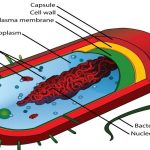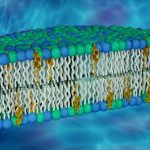All prokaryotic cells have a nucleoid region, DNA and RNA as their genetic material, ribosomes that make proteins, and cytoplasm that contains a cytoskeleton, which organizes and supports the parts of the cell. Prokaryotic cells are simpler than eukaryotic cells, and an organism that is a prokaryote is unicellular; it is made up of only one prokaryotic cell.
Prokaryotic cells are usually between 0.1 to 5 micrometers in length (.00001 to .0005 cm). Eukaryotic cells are generally much larger, between 10 and 100 micrometers. Prokaryotic cells have a higher surface-area-to-volume ratio because they are smaller, which makes them able to obtain a larger amount of nutrients via their plasma membrane.
Prokaryotic Cell Parts
Unlike eukaryotic cells, prokaryotic cells have no distinct organelles bound by membranes. Instead, the many reactions the cell conducts happen within the cytoplasm of the cell. In fact, there are 2 main components that are present within all prokaryotic cells.
The first is a cell membrane. This is a layer of phospholipid molecules which separate the inside of the cell from the outside. While not present in all prokaryotes, many secrete a cell wall, used to protect and house the cell in an extra layer of proteins and structural molecules.
The second part found in all prokaryotic cells is DNA. DNA is the basic blueprint for all life and is found within all cells. In prokaryotes, the DNA often takes the form of a large circular genome. This can be compared to the organized chromosomes which are typically found within eukaryotes. This large circle of DNA directs which proteins the cell creates, and regulates the actions of the cell.
Other prokaryotic cells can have a large number of different parts, such as cilia and flagella to help them move around. While these structures are similar in function to those found within eukaryotes, they often have a different structure. This suggests that the two types of cell have undergone very different selection processes and have independently involved the structures.
How do Prokaryotic Cells Divide?
Prokaryotic cells divide through the process of binary fission. Unlike mitosis, this process does not involve the condensation of DNA or the duplication of organelles. Prokaryotic cells have only a small amount of DNA, which is not stored in complex chromosomes. Further, there are no organelles so there is nothing to divide.
When a prokaryote grows to a large size, the process of binary fission takes place. This process duplicates the DNA, then separates each new strand of DNA into individual cells. This process is simpler than mitosis, and as such bacteria can reproduce much faster.



Comments are closed